Unlocking IE4 Efficiency: How Precision Die-Cast Motor Rotors Are Redefining Performance Standards
This technical summary is based on the academic paper "IE4-class 2.2-kW Induction Motor Design and Performance Evaluation" by Myeong Jin Ko, Sung-Ho Lee, and Soon Sub Park, published in the Journal of the Korean Society of Manufacturing Technology Engineers (2021).
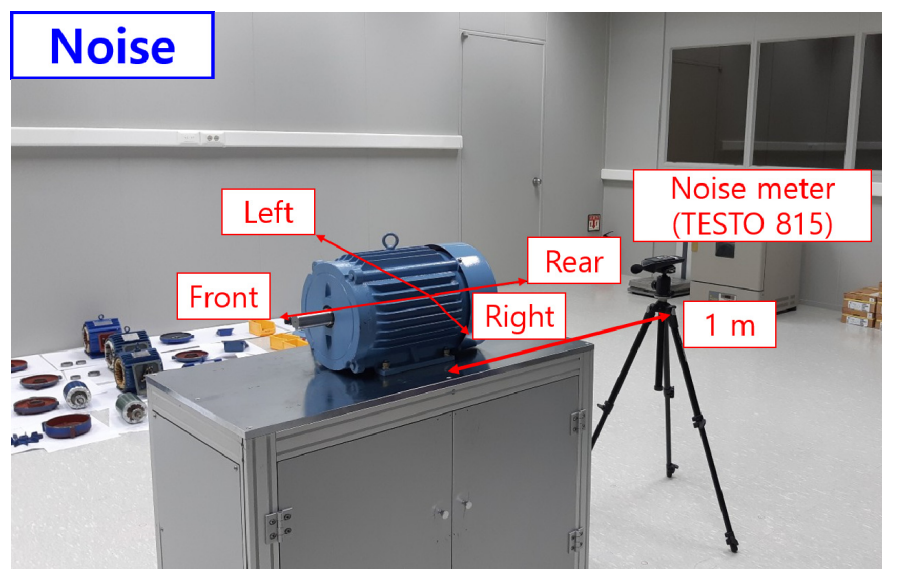
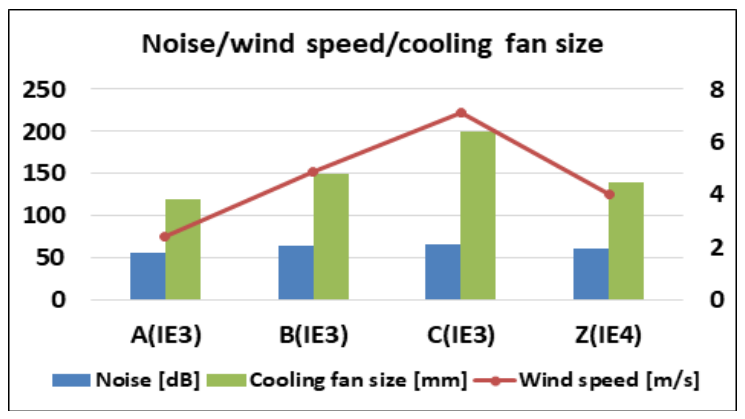
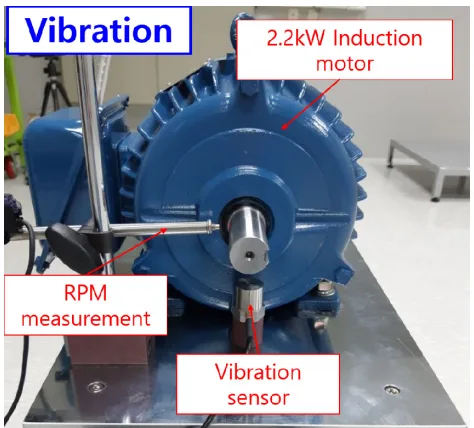
Keywords
- Primary Keyword: Die-Cast Motor Rotors
- Secondary Keywords: Induction Motor Design, IE4 Efficiency, Copper Die Casting, Aluminum Die Casting, Motor Vibration, Noise Reduction
Executive Summary
- The Challenge: The global push for energy conservation demands induction motors that meet super-premium (IE4) efficiency standards, a goal that challenges the limits of traditional die-cast aluminum rotor technology.
- The Method: Researchers designed, fabricated, and tested a prototype 2.2 kW IE4-class induction motor, comparing its performance against leading international models using both die-cast aluminum (Al) and die-cast copper (Cu) rotors.
- The Key Breakthrough: The developed prototype motor with a die-cast Al rotor achieved a 91.0% efficiency rating, exceeding the IE4 standard, while demonstrating superior performance in noise and vibration compared to benchmarked international motors.
- The Bottom Line: Precision manufacturing of die-cast motor rotors, shafts, and assembly components is critical to achieving and exceeding IE4 efficiency, offering a clear pathway for performance improvement in industrial applications.
The Challenge: Why This Research Matters for HPDC Professionals
As global energy standards tighten, the pressure is on to enhance motor efficiency from IE3 to IE4 and even IE5 levels. For induction motors, the heart of the challenge lies in the rotor. While die-cast aluminum rotors are the industry standard, achieving the next leap in efficiency requires materials with higher electrical conductivity. Copper is an ideal candidate, but its high melting temperature makes copper die casting notoriously difficult and costly. This research confronts this exact problem: how to engineer a complete motor system—from the die-cast rotor to the housing—that meets super-premium IE4 efficiency targets while managing the complex trade-offs between materials, performance, and manufacturability. For HPDC professionals, this study underscores the growing demand for high-precision, high-conductivity rotor castings that are central to the next generation of energy-efficient machinery.
The Approach: Unpacking the Methodology
The study undertook a comprehensive approach to design, build, and validate a prototype 2.2 kW IE4-class motor, benchmarking it against commercial products from leading manufacturers.
Method 1: Component Design and Fabrication
Researchers designed and fabricated all key components. A stator was produced with a 43.7% space factor, and stress was removed via heat treatment. For the core of the study, two types of rotors were developed: a die-cast Al skew rotor and a die-cast Cu non-skew rotor, both using 50PN470 core material. A high-precision shaft with less than 10-µm oscillation was machined, and the housing was fabricated from lightweight Al 6061.
Method 2: Assembly and System Optimization
Shrink fitting was used for the assembly of the shaft and rotor bearings. To optimize cooling and noise, the cooling fan size was systematically reduced and prototyped using 3D printing. A 75% size reduction was found to be optimal, providing stable temperature performance with reduced noise.
Method 3: Performance Evaluation
The fully assembled prototype and benchmark motors were subjected to rigorous testing. A field balancer was used to measure motor body vibration, while a three-dimensional coordinate measuring machine determined the air gap between the rotor and stator. Noise was measured from five directions at a 1-meter distance. Finally, a dynamo test was conducted to measure motor efficiency.
The Breakthrough: Key Findings & Data
The performance evaluation revealed that the newly developed motor not only met but exceeded key IE4 benchmarks, providing valuable data on the role of rotor materials and manufacturing precision.
Finding 1: Superior Efficiency and Noise Performance Achieved
The developed prototype motor demonstrated exceptional performance. As shown in Table 3, the version with the die-cast Al rotor achieved 91.0% efficiency, while the die-cast Cu rotor version reached 91.6%. Both figures surpass the IE4 class criterion of 91% for a 2.2-kW motor. Furthermore, the Al rotor prototype produced a noise level of only 58.4 dB, significantly lower than the benchmark international motor's 61.3 dB and well below the 68 dB standard for IE4 motors.
Finding 2: Direct Trade-offs Between Al and Cu Die-Cast Rotors
The study provides a clear comparison of rotor materials. According to Table 3, the die-cast Cu rotor, while more efficient, was heavier (11.46 kg vs. 9.26 kg for Al), noisier (66.3 dB vs. 58.4 dB), and produced more vibration (2.464 µm vs. 1.845 µm). This highlights that while Cu offers an efficiency edge, it introduces significant mechanical challenges in noise and vibration that must be managed through superior balancing and system design. The Al rotor offered a more balanced overall performance profile, excelling in mechanical stability.
Practical Implications for R&D and Operations
- For Process Engineers: This study suggests that focusing on rotor balancing to a tolerance of less than 0.4 g is a critical process parameter for minimizing vibration and noise, especially when working with heavier materials like copper.
- For Quality Control Teams: The data in Table 2 and Table 3 of the paper illustrates the effect of the air gap on vibration and efficiency. The tightest air gap (0.255 mm) on the benchmark motor correlated with lower vibration, suggesting that air gap measurement should be a key quality inspection criterion for high-performance motor assemblies.
- For Design Engineers: The findings indicate that rotor material selection (Al vs. Cu) has a direct impact on not just electrical efficiency but also on mechanical performance (weight, vibration, noise). This suggests that early design phase simulations must account for these trade-offs to optimize the entire motor system, rather than just its electrical characteristics.
Paper Details
IE4-class 2.2-kW Induction Motor Design and Performance Evaluation
1. Overview:
- Title: IE4-class 2.2-kW Induction Motor Design and Performance Evaluation
- Author: Myeong Jin Ko, Sung-Ho Lee, Soon Sub Park
- Year of publication: 2021
- Journal/academic society of publication: Journal of the Korean Society of Manufacturing Technology Engineers
- Keywords: Induction motor, Vibration, Noise, Cu rotor, Al rotor
2. Abstract:
In this study, a 2.2 kW super-premium (IE4) class 4-pole three-phase induction motor was designed and developed. We compared this prototype motor with the industrial induction motors sold by leading international companies. We designed and fabricated a stator, an Al rotor, housing, bearing front and rear covers made of Al 6061, a shaft, and a cooling fan. The cooling fan produced with 3D printing technology was assembled on the unload shaft. Following motor assembly, its mechanical performance, such as noise, vibration, wind speed, and efficiency, was analyzed. Compared with the considered international-standard motors, our proposed motor showed superior performance in terms of noise, vibration, and efficiency but not in terms of air gap and wind speed.
3. Introduction:
To conserve energy and reduce greenhouse gas emissions, Minimum Energy Performance Standards (MEPS) have been implemented globally, promoting the use of high-efficiency motors. The efficiency standard in South Korea was enhanced to IE3 in 2015 and is expected to reach IE4 and IE5 by 2030. Motor losses can be reduced and efficiency improved by replacing die-cast aluminum (Al) rotors with die-cast copper (Cu) rotors, which can lower temperature increases due to reduced rotor heating. However, Cu die casting is difficult due to its high melting temperature. To achieve IE4-class efficiency, the use of rotor materials with high electrical conductivity is required. This necessitates the development of hybrid rotors or advanced motor designs. This study details the design and performance analysis of a 2.2-kW IE4-class induction motor and compares it with products from leading international companies.
4. Summary of the study:
Background of the research topic:
The research is driven by the global trend of enhancing minimum energy performance standards for induction motors to conserve energy. The progression from IE2/IE3 to IE4/IE5 standards requires significant improvements in motor efficiency, primarily through the reduction of motor losses.
Status of previous research:
Previous research has established that replacing die-cast aluminum rotors with die-cast copper rotors can reduce temperature increases and improve efficiency due to lower copper loss. However, the practical application is limited by the manufacturing challenges of Cu die casting. While Al rotors are common for IE3-class motors, achieving IE4 levels necessitates rotor materials with higher electrical conductivity or advanced designs.
Purpose of the study:
The purpose of this study was to design, develop, and evaluate a 2.2 kW super-premium (IE4) class 4-pole three-phase induction motor. The study aimed to compare the mechanical and electrical performance of this prototype, equipped with both Al and Cu rotors, against commercially available motors from leading international companies.
Core study:
The core of the study involved the complete design, fabrication, and assembly of a prototype motor. This included a stator, a die-cast Al rotor, a die-cast Cu rotor, a high-precision shaft, an Al 6061 housing, and a 3D-printed cooling fan. The assembled motor's performance characteristics—specifically noise, vibration, wind speed, air gap, balancing, and efficiency—were systematically measured and analyzed. These results were then benchmarked against data obtained from testing four leading commercial motors (three domestic, one international).
5. Research Methodology
Research Design:
The study employed a comparative experimental design. A prototype 2.2-kW IE4-class induction motor was developed and its performance was benchmarked against existing industrial motors. Two variants of the prototype were created, one with a die-cast Al rotor and another with a die-cast Cu rotor, to directly compare the effect of the rotor material.
Data Collection and Analysis Methods:
Mechanical and electrical performance data were collected using specialized instrumentation. Noise levels were measured according to the KS C IEC 60034-9 standard. Motor body vibration was measured using a field balancer (Sigma). The air gap was measured with a three-dimensional coordinate measuring machine. Rotor balancing was measured at 1,800 rpm using a custom balancing machine. Efficiency was determined through a dynamo test. The collected data were tabulated and compared across all tested motors.
Research Topics and Scope:
The research scope was focused on the design and mechanical performance evaluation of a 2.2-kW, 4-pole, three-phase induction motor intended to meet IE4 efficiency standards. The topics investigated included the impact of rotor material (Al vs. Cu), shaft precision, cooling fan size, and manufacturing tolerances (air gap, balancing) on the motor's overall noise, vibration, and efficiency.
6. Key Results:
Key Results:
- The developed prototype motor with a die-cast Al rotor achieved 91.0% efficiency, and the Cu rotor version achieved 91.6%, both meeting the IE4 standard (≥91%).
- The Al rotor prototype exhibited lower noise (58.4 dB) and vibration (1.845 µm) compared to the Cu rotor prototype (66.3 dB and 2.464 µm).
- The developed Al rotor motor showed superior noise and vibration performance compared to the benchmarked international motor (61.3 dB and 2.290 µm).
- Precision shaft manufacturing reduced shaft oscillation from a standard of 40 µm to below 25 µm.
- Reducing the cooling fan size to 75% of its original design proved optimal for noise reduction without compromising thermal stability.
Figure Name List:
- Fig. 1 Induction motor noise measurement setup
- Fig. 2 Measurement results for induction motor noise/cooling fan size/wind speed
- Fig. 3 Induction motor vibration measurement setup
- Fig. 4 Measurement results for induction motor vibration/air gap/balancing/efficiency
- Fig. 5 Induction motor balancing measurement setup
- Fig. 6 2.2-kW induction motor stator
- Fig. 7 2.2-kW induction motor rotor
- Fig. 8 Shaft design drawing and vibration of shaft measurement setup
- Fig. 9 Fan design drawing and fabrication of fan using 3D printing
- Fig. 10 2.2-kW induction motor stator with frame
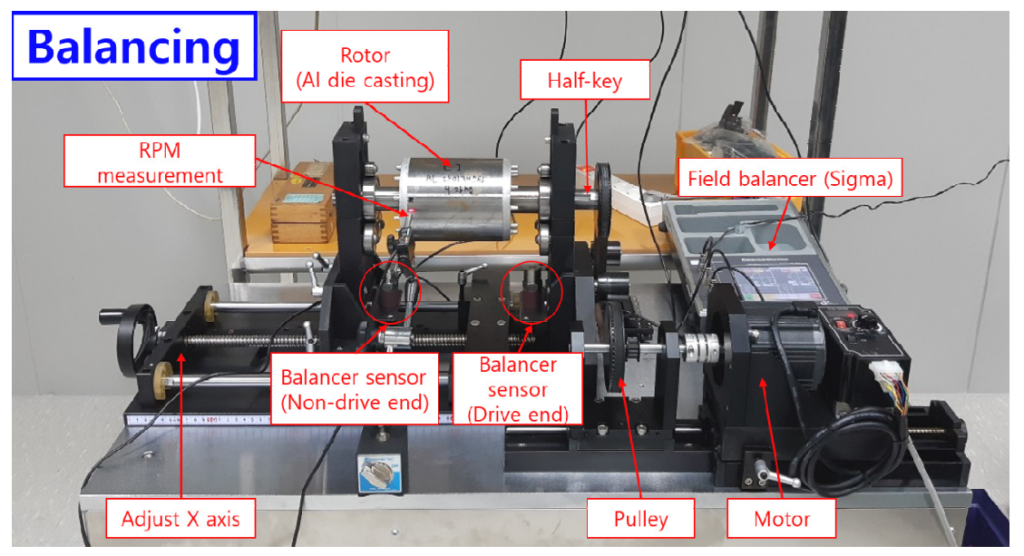
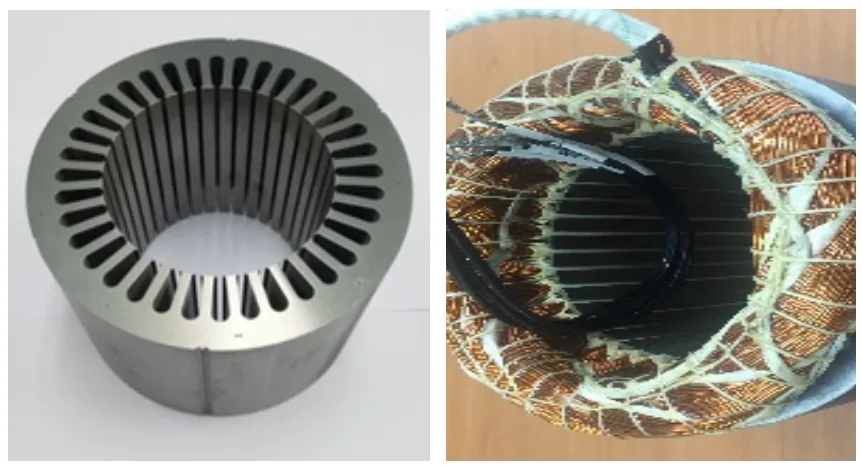
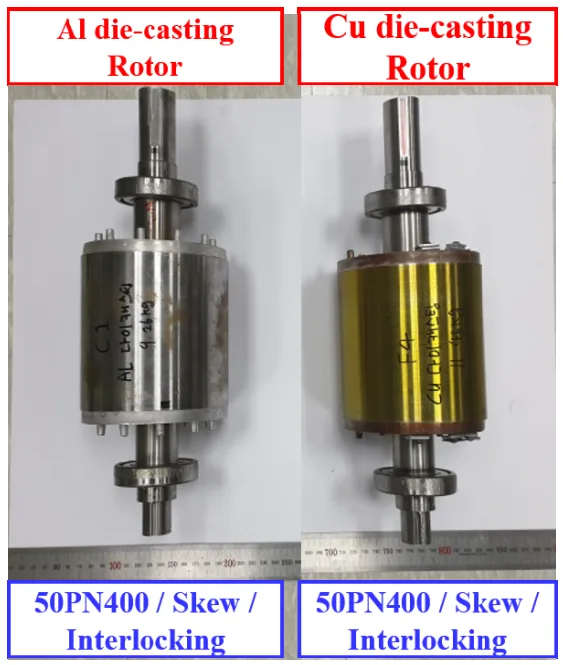

7. Conclusion:
A 2.2-kW IE4-class induction motor was developed and its performance was compared with that of advanced overseas companies. The developed motor demonstrated superior performance in terms of noise, vibration, and efficiency, though not in air gap and wind speed. The use of precision shaft manufacturing technology, with micro-cutting to minimize oscillation to <25 µm, was a key factor. The study concludes that promotion of this technology can improve IE4 motor efficiency. Future development of Al/Cu hybrid rotors, coupled with further improvements in shaft oscillation and a reduction in the air gap to less than 0.25 mm, could enable the development of ultra-premium (IE5) motors.
8. References:
- [1] Lie, S., Pietro, D., 1995, Copper Die-cast Rotor Efficiency Improvement and Economic Consideration, IEEE Trans. Energy Convers., 10:3 419-424, https://doi.org/10.1109/60.464863.
- [2] Peters, D. T., Cowie, J. G., Brush, E. F., Midson, S. P., 2002, Use of High Temperature Die Material and Hot Dies for High Pressure Die Casting Pure Copper and Copper Alloys, Transactions of the North American Die Casting Association Congress.
- [3] Malinowski, J., McCormick, J., Dunn, K., 2004, Advanced in Construction Techniques of AC Induction Motors: Preparation for Super-premium Efficiency Levels, IEEE Trans. Ind. Appl., 40:6 1665-1670, https://doi.org/10.1109/ ΤΙΑ.2004.836300.
- [4] IEC, 2002, Rotating Electrical Machines-Part9: Noise Limits, IEC 60034-9:2002, International Electrotechnical Commission, Geneva.
- [5] Jun, O. S., Kim, J. O., 1999, Free Bending Vibration of a Multi-step Rotor, J. Sound Vibr., 224:4 625-642, https://doi.org/ 10.1006/jsvi.1999.2206.
- [6] Kim, P. Y., 1987, A New Method for the Critical Speed Calculation of Rotor-bearing Systems, Doctoral Dissertation, University of Ottawa, Canada.
- [7] Darlow, M. S., 1987, A Method for Torsional Critical Speed Calculation of Practical Industrial Rotors, Proc. for the International Conference on Vibration Engineering, 759-764.
- [8] IEC, 1991, Dimensions and Output Series for Rotating Electrical Machines Part 1: Frame Numbers 56 to 400 and Flange Numbers 55 to 1080, IEC 60072-1, International Electrotechnical Commission, Geneva.
- [9] Darlow, M. S., 1987, Balancing of High-Speed Machinery: Theory, Methods and Experimental Results, Mech. Syst. Signal Proc., 1:1 105-134, https://doi.org/10.1016/0888-3270(87)900 87-2.
- [10] ISO, 1986, Mechanical Vibration-Balance Quality Requirements of Rigid Rotors-Part 1: Determination of Permissible Residual Unbalance, ISO 1940-1, International Organization for Standardization, Geneva.
- [11] ISO, 1998, Mechanical Vibration-Methods and Criteria for the MechanicalBalancing of Flexible Rotors, ISO 11342, International Organization for Standardization, Geneva.
- [12] Lee, C.-W., 1993, Vibration Analysis of Rotors, Kluwer Academic Publishers, The Netherlands.
- [13] Beyer, W. H., 1979, CRC Standard Mathematical Tables, CRC Press, Boca Raton, FL, USA.
- [14] ISO, 1990, Vibration and Shock-Experimental Determination of Mechanical Mobility-Part 2: Measurements Using Single-point Translational Excitation with an Attached Vibration Exciter, ISO 7626-2, International Organization for Standardization, Geneva.
Expert Q&A: Your Top Questions Answered
Q1: What was the primary difference in performance between the die-cast Al rotor and the die-cast Cu rotor in the prototype?
A1: The die-cast Cu rotor achieved a slightly higher efficiency of 91.6% compared to the Al rotor's 91.0%. However, this came with significant trade-offs: the Cu rotor was heavier (11.46 kg vs. 9.26 kg) and resulted in considerably higher noise (66.3 dB vs. 58.4 dB) and vibration (2.464 µm vs. 1.845 µm). This indicates that while Cu offers superior electrical conductivity, its greater mass poses mechanical challenges.
Q2: How was shaft oscillation addressed, and what was the result?
A2: The study used precision grade shaft manufacturing with a fine cutting process. This shaft micro-cutting technology improved the shaft oscillation level from the general standard of 40 µm to less than 25 µm, representing over 60% superiority. A shaft with less than 10-µm oscillation was ultimately selected for the final assembly, which was critical for minimizing overall motor vibration.
Q3: Why was the cooling fan size modified, and what was the optimal design?
A3: The cooling fan size was minimized to improve the overall efficiency of the induction motor by reducing aerodynamic load and noise. Prototypes were made at 75% and 50% of the original size. The study found that reducing the fan size to 75% was the most ideal, as it successfully reduced noise while ensuring the temperature rise of the motor remained stable.
Q4: The paper mentions the developed motor was superior in most areas but not in air gap. Can you elaborate?
A4: The developed motor with the Al rotor had an air gap of 0.302 mm, and the Cu rotor had 0.289 mm. As shown in Table 3, the benchmark international motor (Z) had a significantly smaller air gap of 0.255 mm. A smaller air gap generally leads to better magnetic flux and higher efficiency, so this represents an area for future improvement in the prototype's design.
Q5: What does the study suggest is necessary to achieve the next level of efficiency (IE5)?
A5: The conclusion of the paper suggests a multi-faceted approach to reach IE5 efficiency. This includes the future development of Al/Cu hybrid rotors to combine the benefits of both materials. Additionally, it will require further improvements in manufacturing precision, specifically by reducing shaft oscillations even more and tightening the air gap to less than 0.25 mm.
Conclusion: Paving the Way for Higher Quality and Productivity
The global mandate for energy efficiency has placed the performance of induction motors under intense scrutiny. This research clearly demonstrates that achieving super-premium IE4 standards is not just about material science, but about a holistic approach to design and precision manufacturing. The performance of Die-Cast Motor Rotors is intrinsically linked to the quality of the entire system, from shaft balancing to the air gap tolerance. The study's prototype, with its superior noise, vibration, and efficiency metrics, proves that a focus on high-precision manufacturing yields tangible results that outperform even established industry leaders.
"At CASTMAN, we are committed to applying the latest industry research to help our customers achieve higher productivity and quality. If the challenges discussed in this paper align with your operational goals, contact our engineering team to explore how these principles can be implemented in your components."
Copyright Information
This content is a summary and analysis based on the paper "IE4-class 2.2-kW Induction Motor Design and Performance Evaluation" by "Myeong Jin Ko, Sung-Ho Lee, Soon Sub Park".
Source: https://doi.org/10.7735/ksmte.2021.30.5.345
This material is for informational purposes only. Unauthorized commercial use is prohibited.
Copyright © 2025 CASTMAN. All rights reserved.